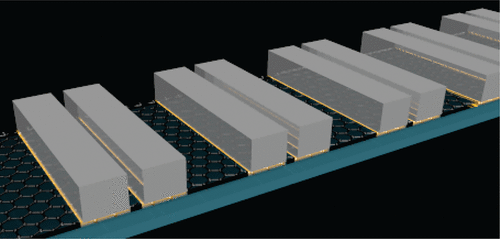当前位置:
X-MOL 学术
›
ACS Photonics
›
论文详情
Our official English website, www.x-mol.net, welcomes your
feedback! (Note: you will need to create a separate account there.)
Topological Graphene Plasmons in a Plasmonic Realization of the Su–Schrieffer–Heeger Model
ACS Photonics ( IF 6.5 ) Pub Date : 2021-05-24 , DOI: 10.1021/acsphotonics.1c00417 Tatiana G. Rappoport 1, 2 , Yuliy V. Bludov 3 , Frank H. L. Koppens 4, 5 , Nuno M. R. Peres 3, 6
ACS Photonics ( IF 6.5 ) Pub Date : 2021-05-24 , DOI: 10.1021/acsphotonics.1c00417 Tatiana G. Rappoport 1, 2 , Yuliy V. Bludov 3 , Frank H. L. Koppens 4, 5 , Nuno M. R. Peres 3, 6
Affiliation

|
Graphene hybrids, made of thin insulators, graphene, and metals can support propagating acoustic plasmons (AGPs). The metal screening modifies the dispersion relation of usual graphene plasmons leading to slowly propagating plasmons, with record confinement of electromagnetic radiation. Here, we show that a graphene monolayer, covered by a thin dielectric material and an array of metallic nanorods, can be used as a robust platform to emulate the Su–Schrieffer–Heeger model. We calculate the Zak’s phase of the different plasmonic bands to characterize their topology. The system shows bulk-edge correspondence: strongly localized interface states are generated in the domain walls separating arrays in different topological phases. We find signatures of the nontrivial phase which can directly be probed by far-field mid-IR radiation, hence allowing a direct experimental confirmation of graphene topological plasmons. The robust field enhancement, highly localized nature of the interface states, and their gate-tuned frequencies expand the capabilities of AGP-based devices.
中文翻译:

Su-Schrieffer-Heeger 模型等离子体实现中的拓扑石墨烯等离子体
由薄绝缘体、石墨烯和金属制成的石墨烯混合体可以支持传播声等离子体 (AGP)。金属屏蔽改变了通常的石墨烯等离子体的色散关系,导致缓慢传播的等离子体,并记录了电磁辐射的限制。在这里,我们展示了由薄介电材料和一系列金属纳米棒覆盖的石墨烯单层,可以用作模拟 Su-Schrieffer-Heeger 模型的强大平台。我们计算不同等离子体带的 Zak 相位来表征它们的拓扑结构。该系统显示体边缘对应:在不同拓扑相中分隔阵列的畴壁中产生强局部界面态。我们发现了可以直接通过远场中红外辐射探测的非平凡相位的特征,因此允许直接实验确认石墨烯拓扑等离子体。强大的场增强、界面态的高度局部性以及它们的门调谐频率扩展了基于 AGP 的设备的功能。
更新日期:2021-06-17
中文翻译:

Su-Schrieffer-Heeger 模型等离子体实现中的拓扑石墨烯等离子体
由薄绝缘体、石墨烯和金属制成的石墨烯混合体可以支持传播声等离子体 (AGP)。金属屏蔽改变了通常的石墨烯等离子体的色散关系,导致缓慢传播的等离子体,并记录了电磁辐射的限制。在这里,我们展示了由薄介电材料和一系列金属纳米棒覆盖的石墨烯单层,可以用作模拟 Su-Schrieffer-Heeger 模型的强大平台。我们计算不同等离子体带的 Zak 相位来表征它们的拓扑结构。该系统显示体边缘对应:在不同拓扑相中分隔阵列的畴壁中产生强局部界面态。我们发现了可以直接通过远场中红外辐射探测的非平凡相位的特征,因此允许直接实验确认石墨烯拓扑等离子体。强大的场增强、界面态的高度局部性以及它们的门调谐频率扩展了基于 AGP 的设备的功能。











































 京公网安备 11010802027423号
京公网安备 11010802027423号